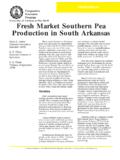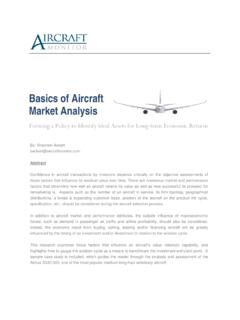Transcription of University of Arkansas at Pine Bluff Commercial …
1 Cooperative Extension Horticulture Program University of Arkansas at Pine Bluff Commercial Fresh Market Southern Pea Production Dr. Henry English Southern peas are grown for both (embryo area) or by spacing Assistant Professor fresh market and processing in (crowding) of seeds within pods. Department of Agriculture Arkansas . Approximately 1,900 acres For example, there are purple hulls, of Southern peas are grown for cream peas, pink or black-eyed peas University of Arkansas processing and 2,000 acres of Southern and crowder peas. Classification at Pine Bluff peas are harvested and sold on the often overlaps ( , pinkeye purple fresh market. Southern peas are hull). Dr. Owen Porter known as cowpeas, field peas, crowder Professor peas, purple hull peas and black-eyed Varieties Department of Agriculture peas. While many types are available, University of Arkansas the basic cultural practices are the There are many varieties of at Pine Bluff same for all types.
2 Southern peas. Choose a variety based Southern peas are identified by on the market demand. Some poplar Dr. Joseph G. Burleigh varieties are listed in Table 1. color of hull, seed and eye or hilum Professor Department of Agriculture University of Arkansas Popular Varieties of Southern Peas at Pine Bluff Pod Plant Seed Disease Dry Variety Color Habit Type Maturity Tolerance Yields Pink Eye Purple Hull Purple SV Pink eye Late . Pinkeye Purplehull BVR Purple V Pink eye Mid V . Coronet Purple SV Pink eye Mid 1133. Texas Pinkeye Purple B Pink eye Mid 1216. Mississippi Pinkeye Purple V Pink eye Mid FNV . Quickpick Purple B Pink eye Mid 1019. California Pinkeye Purple SV Pink eye Mid 1023. Whippoorwill Brown V Brown speck Late 1009. Green to Zipper Cream white V Cream Mid 1323. Ark Blackeye Cream V Black eye Early 1209. Plant Habits: SV = Semi-Vining, V = Vining, B = Bushy Disease Tolerance: V = Mosaic Virus, F = Fusarium wilt, N = Nematodes Dry Yields: Yields are for pounds/acre of non-irrigated peas harvested dry over a three or four year period (1996-1997) at the UAPB Lonoke Farm.
3 However, yields for Quickpick are for one year (1999) at the UAPB Experiment Station. University of Arkansas at Pine Bluff , United States Department of Agriculture, and County Governments Cooperating Soils Pine Bluff (UAPB), approximately 8 to 10 seeds per foot of row (30-inch rows) are planted. Plant seeds Southern peas grow on a variety of soils but from to inches deep in rows spaced 30 to sandy loams to silty clay loams are preferred. In 42 inches apart depending on cultivation requirements. addition, soils with a medium fertility plus a pH. between and are also preferred. Avoid soils with excessively high fertility because this produces Irrigation Studies excessive vine growth and poor yields. Plant on soils that have good drainage because peas do not tolerate Studies conducted at Lonoke, Arkansas , in 1998. wet soils. Wet soils cause stunting and make peas showed that flood and furrow irrigation had similar more susceptible to root and foliar diseases.
4 Yields. Both had higher yields than the non-irrigated plots. However, the furrow irrigated plots used considerably less water and required less time to Fertilizers irrigate than the flooded plots. The critical irrigation period is during blooming. Maintain uniform moisture Fertilize according to soil test recommendation. throughout fruit set and pod development. For Peas require plenty of potash and phosphorus. Band highest yield, peas should receive 1 inch of water fertilizer 3/4 inches deep and 2 to 3 inches away from each week from prebloom to pod fill either by rainfall seed or broadcast and disc in all fertilizer (including or by irrigation. nitrogen) before planting. Most peas have nitrogen- fixing bacteria (some varieties are non-nitrogen fixing). However, peas usually respond to a small Insect Control initial application of nitrogen fertilizer. Inoculations of seeds with nitrogen-fixing bacteria may increase The cow pea aphid is an insect that may appear yields, especially in soils where Southern peas have in spots on early planted peas.
5 Generally no treatment not been grown in the past three years. is required for control due to the parasitic fungi that attacks the aphids. If an insecticide is needed, it may only be needed in spots. To control the cow pea aphid, Planting Date apply Malathion or other recommended chemicals. Surface soil should be 60 to 65 degrees F before In late planted crops, the cow pea aphid population planting; however, optimum soil temperature for should be monitored closely and treated if needed. germination ranges from 70 to 95 degrees F. Seeding Other insects that appear in late crops are stink bug too early causes poor stands due to cool, wet soils; and corn earworms. These insects, however, generally and cool temperatures in early spring cause slow require no control. growth and make the peas more susceptible to attack by thrips. Thrips often attack peas that are planted close to mature wheat fields.
6 However, no insecticides are A seed treatment (fungicide) may be used when generally required. Consult the Cooperative planting in less than optimum conditions. Optimum Extension publication, MP 144, for insecticides that planting dates range from mid-May to mid-July. may be used on peas. Planting after mid-July usually leads to reduced yields and greater potential for cow pea aphid infestations. To have a continuous supply of fresh Weed Control market peas, plant on a two to three week schedule. Weeds should be controlled early with either shallow cultivation and/or herbicides. The herbicides Spacing and Seeding Rate Treflan, Dual and Poast may be used for grass control while Basagran and Pursuit may be used to control Seeding rates depend on seed size, germination broadleaves. It is essential to spray broadleaf weeds percentage and row spacing. A general seeding rate early for effective control.
7 Consult the Cooperative between 20 to 25 pounds per acre is recommended. Extension publication, MP 44, for herbicides that may In research plots at the University of Arkansas at be used on peas. Disease Control Post Harvest Handling Southern peas planted under unfavorable Peas easily heat and spoil after harvest, so keep conditions (cool and wet) are often infected with root cool or shaded and well-ventilated. Field heat should rots or seedling diseases. To control, plant when soil be removed from peas soon after harvest with forced temperatures and weather conditions are ideal for air cooling. Peas can be stored for three to four days plant growth or use the appropriate seed treatments. at 50 to 45 degrees F and 80 and 90 percent relative Also, avoid seeds that may carry fungi by using humidity. Peas cooled below 45 degrees F may show high-quality treated seeds. chilling injury. Fusarium wilt infects Southern peas.
8 Symptoms Shelled peas should also be cooled rapidly. Fresh of Fusarium wilt include stunted and wilted plants and brick red tissue in stems that are split lengthwise. shelled peas can be stored in plastic cello bags for five The best control of Fusarium wilt is the use of to seven days at 32 degrees F and 90 to 95 percent resistant varieties. relative humidity. Root-knot nematodes infect roots which become knotted and galled. Do not confuse galled roots with Grades nodulating bacteria. Galls are within the roots;. nodules are attached to sides of the roots. Symptoms Unshelled peas are graded as No. 1 and of nematode infected plants appear as nutrient Commercial . In the , to grade No. 1, 95 percent of deficiencies, stunting and wilting. Injuries to the roots pods must be at least 5 inches long. For the also make the plant susceptible to attack by Commercial , no minimum length is required.
9 Both Fusarium wilt. The best control methods are resistant categories consist of pods of similar varietal charac- varieties and crop rotation. teristics which are fairly well-formed, fairly Several viruses also attack Southern peas. Leaf well-filled, not over mature or excessively young. symptoms include an intermixing of light and dark Pods must also be free from decay, worm holes and green areas. Infected plants are usually dwarfed and free from damage caused by stems, leaves, trash, bunchy and yields are reduced. Plants infected during stings or other insect injuries and scars, discoloration, seedling stages may be barren and fail to produce. The wilting, dirt or adhering foreign material, disease, best method of control is to grow resistant varieties. mechanical injuries or other means. Consult the Cooperative Extension publication, MP 154, for fungicides that may be used on peas.
10 Packing Harvest Peas are packed in bushel hampers or mesh bags weighing 25 pounds net. Shelled peas are also packed Harvest peas for the local fresh market by hand. in cardboard cartons containing twelve 11-ounce All fresh market peas are harvested at the green cello bags. mature stage. Purple hull peas are harvested when pods are 50 percent purple with well-formed peas. One person can harvest 12 to 20 bushels of Yield Southern peas per day if yields are average; and it requires one half to one hour to pick a bushel of peas. Good yields range from 60 to 100 bushels per Approximately 100 man hours are required to harvest acre. Irrigated crops have the higher (100 bushels). an acre of peas with a yield of 100 bushels per acre. yields. Peas can also be machine harvested at the green mature stage. However, due to the often low pod quality of machine harvested fresh peas, these peas Marketing are generally shelled with a mechanical pea sheller prior to marketing.








